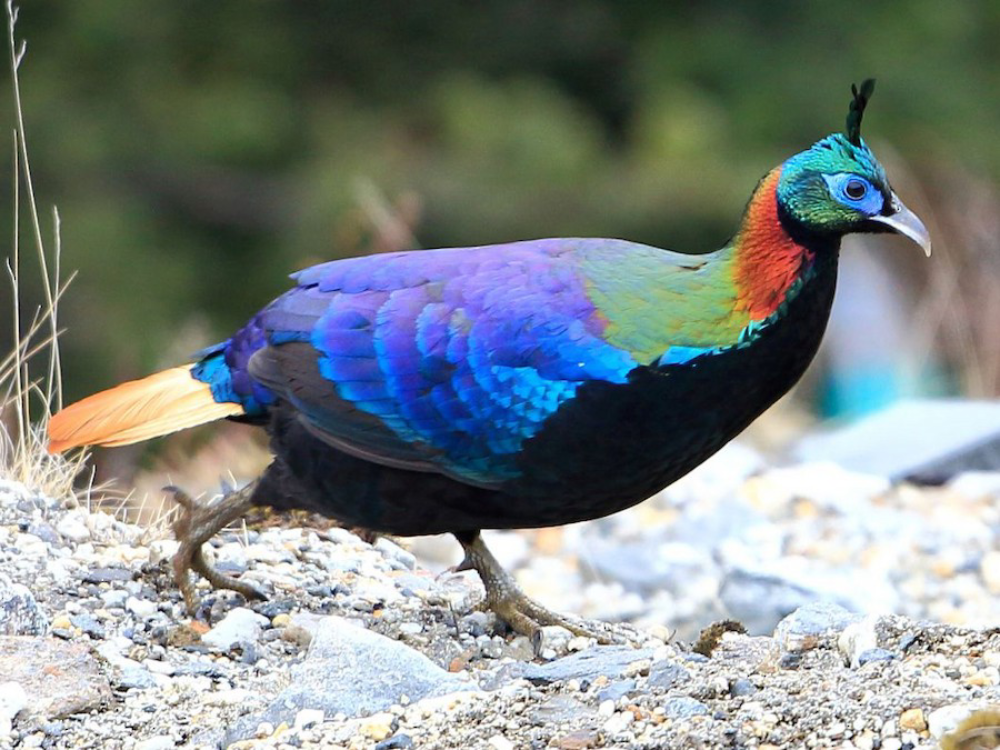The Himalayan Monal, also known as the Impeyan Monal or Impeyan Pheasant, is a vibrant and captivating bird species native to the mountainous regions of South Asia. Scientifically named Lophophorus impejanus, this bird is a member of the pheasant family, Phasianidae. Renowned for its striking plumage and significant cultural and ecological roles, the Himalayan Monal is the national bird of Nepal and the state bird of Uttarakhand, India. This article delves into the rich tapestry of the Himalayan Monal’s biology, habitat, behavior, cultural significance, and conservation status.
Taxonomy and Nomenclature
The Himalayan Monal was first described by John Latham in 1790. The species name “impejanus” honors Lady Mary Impey, the wife of the British Chief Justice of Bengal, Sir Elijah Impey, who was an avid naturalist and had kept these birds in her private menagerie. The monal’s scientific name, Lophophorus impejanus, reflects this tribute. The genus name “Lophophorus” is derived from Greek words “lophos,” meaning crest, and “phoros,” meaning bearing, indicative of the bird’s prominent head crest.
Physical Description
The Himalayan Monal is one of the most visually stunning birds in the world. The males are particularly notable for their iridescent plumage, which changes color with the angle of the light. The male Monal boasts a metallic green head crest, coppery neck, bright red rump, and a mix of vibrant blue, green, and purple on its body. This dazzling coloration serves not only to attract mates but also to assert dominance over territory.
In contrast, the female Monal is less conspicuous, with her brownish plumage providing effective camouflage in the dense undergrowth of her habitat. Despite the more subdued coloration, the female is still a striking bird, with intricate patterns of browns and blacks that help her blend into her environment, especially during nesting.

Habitat and Distribution
The Himalayan Monal is found in the high-altitude regions of the Himalayas, spanning across countries such as Nepal, India, Bhutan, Myanmar, and Tibet. These birds prefer alpine and subalpine zones, typically between altitudes of 2,500 to 5,000 meters. Their habitat includes forests of rhododendron, coniferous woods, and grassy slopes. During the summer, Monals migrate to higher elevations, while in winter, they descend to lower altitudes to escape the harsh weather.
These birds thrive in environments that offer a combination of open spaces for foraging and dense cover for protection against predators. The dense forests and alpine meadows of the Himalayas provide an ideal setting for these birds to live and breed.
Behavior and Diet
The Himalayan Monal is primarily a ground-dwelling bird, although it roosts in trees at night to avoid predators. It is an omnivorous species with a diverse diet that includes roots, tubers, seeds, insects, and small invertebrates. The bird uses its strong beak to dig into the ground, searching for food. This foraging behavior also helps aerate the soil, playing a beneficial role in the ecosystem.
Monals are generally shy and elusive, often moving silently through the underbrush. However, during the breeding season, males become more vocal and display their plumage to attract females. The courtship display involves the male fanning out his feathers, bobbing his head, and making a series of calls to entice potential mates.
Breeding typically occurs from April to June, coinciding with the spring thaw in the Himalayas. Females lay between three to five eggs, which they incubate for about 27 days. The chicks are precocial, meaning they are relatively mature and mobile shortly after hatching.
Cultural Significance
The Himalayan Monal holds a significant place in the cultural fabric of the regions it inhabits. In Nepal, it is known as the “Danphe” and is celebrated in folklore, art, and mythology. Its vibrant feathers have historically been used in traditional attire and headdresses, symbolizing beauty and nobility.
In India, the bird is associated with the state’s identity in Uttarakhand, where it is featured prominently in local emblems and as a symbol of natural heritage. The bird’s image is often used in cultural festivals and conservation campaigns, reflecting its importance to the people of the region.
Conservation Status
The Himalayan Monal is classified as a species of “Least Concern” by the International Union for Conservation of Nature (IUCN). However, this status does not mean the bird faces no threats. Habitat destruction, primarily due to deforestation, agricultural expansion, and infrastructure development, poses significant risks to its population. Additionally, poaching for its beautiful feathers and hunting for meat have contributed to local declines in some areas.
Conservation efforts are underway to protect the Himalayan Monal and its habitat. National parks and protected areas in Nepal, India, and Bhutan serve as vital refuges for these birds. Furthermore, awareness campaigns and community engagement programs aim to reduce human-wildlife conflict and promote sustainable land-use practices.
Conclusion
The Himalayan Monal is not only a symbol of natural beauty but also an integral part of the ecological and cultural landscapes of the Himalayas. Its striking appearance and intriguing behaviors make it a subject of fascination for ornithologists and nature enthusiasts alike. Ensuring the survival of this magnificent bird requires ongoing conservation efforts, habitat protection, and community involvement. By safeguarding the Himalayan Monal, we also preserve the rich biodiversity and cultural heritage of one of the world’s most extraordinary mountain ranges.









